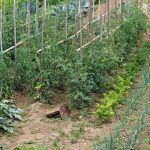What kind of vegetables do people grow in their gardens? Many individuals enjoy the satisfaction and health benefits of cultivating their own produce. From tomatoes and peppers to root vegetables like carrots and potatoes, there is a wide variety of options for home gardeners. In this article, we will explore the joy of growing your own vegetables, provide tips for planning your garden, and highlight popular, unique, and seasonal vegetables that can be grown at home.
Growing your own vegetables not only allows you to enjoy fresh, organic produce but also provides a sense of accomplishment and connection to nature. Whether you have a spacious backyard or a small balcony, there are options for creating a thriving vegetable garden. This article will guide you through the process of planning your garden, from selecting the right location to understanding the importance of soil quality and sunlight for different types of vegetables.
For many home gardeners, popular choices include tomatoes, peppers, and cucumbers. These versatile vegetables are relatively easy to grow and can thrive in various growing conditions. Additionally, we will explore root vegetables like carrots, potatoes, and beets; leafy greens such as lettuce, spinach, and kale; as well as herbs like basil, parsley, and cilantro.
Finally, we will delve into unique and seasonal vegetables that offer an exciting challenge for those looking to expand their gardening repertoire. Whether you are a seasoned gardener or just starting out, there is something for everyone in the world of home vegetable gardening.
Planning Your Garden
When it comes to planning your vegetable garden, there are a few key factors to consider in order to ensure the success of your crop. Selecting the right location for your garden is crucial, as most vegetables require at least 6 hours of sunlight a day.
It is also important to choose an area with good soil quality, as well-draining soil that is rich in nutrients will promote healthy growth for your vegetables. Consider the space you have available and plan accordingly, making sure that your plants have enough room to grow without crowding each other.
In addition to sunlight and soil quality, it’s essential to take into account the types of vegetables you want to grow when planning your garden. Some vegetables, such as tomatoes and peppers, thrive in warm environments and will need a spot with plenty of sun exposure.
On the other hand, leafy greens like lettuce and spinach prefer cooler temperatures and partial shade. Understanding the specific needs of the vegetables you want to grow will help you determine the best location within your garden for each type of plant.
To make it easier for you to get started with planning your own vegetable garden, here are some tips for selecting the right location and ensuring ideal growing conditions:
- Choose a spot with ample sunlight for sun-loving vegetables like tomatoes, peppers, and cucumbers.
- Opt for well-draining soil that is rich in organic matter.
- Consider raised beds or containers if you have limited space or poor soil quality.
- Use a moisture meter to monitor soil moisture levels regularly.
By carefully considering these factors before planting, you can set yourself up for a successful and bountiful vegetable garden. Whether you are growing your own tomatoes or cultivating leafy greens, proper planning will ensure that your garden thrives throughout the growing season.
Popular Vegetables for Home Gardens
When it comes to deciding what kind of vegetables do people grow in their gardens, there are several popular options that are commonly cultivated in home gardens. These vegetables are not only easy to grow but also provide a bountiful harvest, making them a favorite among gardeners. Whether you have limited space or a sprawling backyard, there is always room for these popular vegetables in your garden.
Tomatoes
Tomatoes are arguably the most popular vegetable grown in home gardens. With various types and sizes to choose from, including cherry tomatoes, beefsteak tomatoes, and roma tomatoes, there is a variety suitable for every taste and purpose. Tomatoes require ample sunlight and well-drained soil to thrive and can be grown directly in the ground or in containers.
Peppers
Another favorite among home gardeners is peppers, which come in different colors, shapes, and levels of spiciness. Whether you prefer sweet bell peppers or hot chili peppers, they all flourish when provided with plenty of sunlight and moderately moist soil. Peppers can be grown alongside tomatoes for a colorful and flavorful harvest.
Cucumbers
Cucumbers are an excellent choice for home gardens due to their versatility and abundant yield. They can be trellised or allowed to sprawl on the ground, making them suitable for both small and large gardens. Cucumbers thrive in well-drained soil with consistent moisture and benefit from regular harvesting to encourage continuous production.
These popular vegetables not only provide fresh produce for your kitchen but also add beauty and vitality to your garden landscape. With proper care and attention to their growing requirements, these vegetables are sure to reward you with a satisfying harvest throughout the growing season.
Root Vegetables
When planting root vegetables, it is essential to choose a location with well-draining soil and adequate sunlight. Proper watering is also crucial, as these vegetables depend on consistent moisture for healthy growth. Many gardeners prefer to grow root vegetables from seeds rather than transplanting seedlings, as this allows for better control over the growing conditions.
Harvesting root vegetables is an exciting part of gardening, as it reveals the results of your hard work. It is important to harvest these vegetables at the right time to ensure optimal flavor and texture. Carrots are usually ready for harvesting when they reach a certain size and color, while potatoes can be harvested when the tops of the plants start to die back.
Beets are typically ready for harvest when they reach about 1-3 inches in diameter. With proper care and attention, growing root vegetables can be a rewarding experience for any home gardener looking to add fresh produce to their kitchen.
The appeal of root vegetables lies in their ability to add depth of flavor and nutrients to meals throughout the year. Whether added to soups or roasted as a side dish, these versatile vegetables provide endless culinary possibilities for home cooks. So if you’re wondering what kind of vegetables do people grow in their gardens, rest assured that root veggies like carrots, potatoes, and beets are always among the favorites due to their ease of growth and delicious taste.
Leafy Greens
When it comes to growing leafy greens in your garden, it’s important to consider the ideal growing conditions for each type of vegetable. For instance, lettuce thrives in cooler temperatures and partial shade, while spinach prefers well-drained soil and full sunlight. Kale is known for its hardiness and can withstand a range of growing conditions, but it generally does best in rich soil with consistent moisture.
Many gardeners appreciate the relatively short growing seasons of leafy greens, which means they can enjoy an abundant harvest multiple times throughout the year. With proper care and attention to watering and fertilization, home gardeners can have success with their leafy green crops regardless of the size of their garden plot or experience level. Whether growing in raised beds or containers on a patio or balcony, leafy greens are a rewarding choice for anyone interested in cultivating their own vegetables.
| Leafy Greens | Information |
|---|---|
| Commonly Grown Varieties | Lettuce, Spinach, Kale |
| Ideal Growing Conditions | Cooler temperatures for lettuce, well-drained soil for spinach |
| Growing Seasons | Short growing seasons allow for abundant harvests |
Herbs
When it comes to growing your own vegetables, herbs are a popular and versatile choice for many home gardeners. Herbs like basil, parsley, and cilantro not only add flavor to your meals but also offer an array of health benefits. Many people choose to grow these herbs in their gardens because of their ease of care and the ability to use them fresh in cooking.
Basil, for example, thrives in warm, sunny conditions and can be grown both indoors and outdoors. This fragrant herb is a staple in Italian cuisine and is often used to make pesto, salads, or as a garnish on pizza. Similarly, parsley is a biennial herb that can be grown year-round in temperate climates. It adds a burst of freshness to dishes and is widely used in Mediterranean and Middle Eastern cuisines.
Cilantro, on the other hand, is a cool season herb that prefers partial shade when grown in warmer climates. This herb is commonly used in Mexican, Indian, and Southeast Asian recipes to add a zesty kick to dishes. By incorporating these herbs into your garden, you can enhance the flavors of your meals while reaping the benefits of homegrown produce.
In addition to adding flavor to your food, growing herbs also provides an opportunity for relaxation and stress relief through gardening activities. Overall, herbs are an excellent choice for any home garden due to their versatility and numerous benefits.
Unique and Unusual Vegetables
When it comes to starting a vegetable garden, most people tend to focus on the more common varieties such as tomatoes, peppers, and cucumbers. However, there is a whole world of unique and unusual vegetables that can be grown in home gardens, adding diversity and excitement to your harvest. So, what kind of vegetables do people grow in their gardens that are considered unique or unusual? Let’s explore some of these fascinating options.
Artichokes are an example of a unique vegetable that can be grown in a home garden. While they may require some extra care and attention compared to other vegetables, the reward of harvesting and cooking your own artichokes is well worth the effort. Okra is another interesting option for home gardeners, with its tall stalks and edible seed pods.
This warm-season vegetable thrives in hot climates and can be a fun addition to any garden. Lastly, kohlrabi is an unusual vegetable that belongs to the cabbage family, known for its bulbous stem that can be eaten raw or cooked.
These unique and unusual vegetables may present some challenges when it comes to growing requirements, but they also offer a sense of adventure and discovery for the avid gardener. Incorporating these less commonly grown vegetables into your garden can provide a new level of enjoyment and satisfaction as you witness their growth and finally reap the rewards at harvest time.
| Vegetable | Growing Requirements |
|---|---|
| Artichokes | Well-drained soil, full sun, regular watering |
| Okra | Hot climate, fertile soil, consistent moisture |
| Kohlrabi | Cool weather, fertile soil, regular watering |
Seasonal Vegetables
When it comes to growing vegetables in your garden, it’s important to consider the season in which you plan to plant and harvest. Different vegetables thrive in different seasons, so understanding which ones are best suited for each time of year is essential for a successful garden. In this section, we will discuss the importance of planting seasonal vegetables and provide a guide to help you plan and harvest your crops throughout the year.
Planting for Spring
In the spring, many gardeners look forward to planting cool-season vegetables such as lettuce, peas, and radishes. These vegetables not only tolerate cooler temperatures but actually prefer them. As the weather warms up, you can also start planting warm-season crops like tomatoes, peppers, and squash towards the end of spring, ensuring a bountiful harvest in the summer months.
Summer Harvest
During the summer months, it’s time to enjoy an abundance of fresh produce from your garden. This is the perfect time to plant heat-loving vegetables such as corn, cucumbers, and zucchini. Additionally, maintaining consistent watering and providing shade for sensitive plants becomes crucial to ensure they thrive despite the hot weather.
Fall Planting
As summer transitions into fall, it’s important to continue tending to your garden with cooler weather in mind. Vegetables like broccoli, cauliflower, and carrots are excellent choices for fall planting as they withstand frost well and offer a flavorful harvest that can last well into winter. Don’t forget about herbs like thyme and sage which also flourish during this time.
Whether you’re a seasoned gardener or just starting out with your vegetable garden, understanding the best seasonal vegetables for planting is key to a successful yield. By planning ahead and working with nature’s natural rhythm, you can enjoy an array of fresh produce throughout the year while reaping all the benefits that come with growing your own food.
Conclusion
In conclusion, the joy and rewards of growing your own vegetables are plentiful. Not only does cultivating a garden provide a sense of satisfaction and accomplishment, but it also offers numerous health benefits. With the ability to grow a wide variety of vegetables in your own backyard, you can ensure access to fresh, nutritious produce while also enjoying the process of gardening.
From popular choices like tomatoes and peppers to more unique options like artichokes and kohlrabi, there is no shortage of vegetables that can be grown in a home garden. The planning and cultivation of a vegetable garden requires careful consideration of factors such as location, soil quality, sunlight, and seasonal variations. By understanding these elements and being diligent in tending to the needs of your plants, you can create a thriving garden that yields an abundance of delicious vegetables.
The beauty of growing your own vegetables lies in the connection with nature, the satisfaction of harvesting your own food, and the opportunity to savor truly fresh produce. Whether you have ample space for a large garden or are confined to growing herbs in containers on a balcony, there is something for everyone when it comes to vegetable gardening.
So why not start your own vegetable garden today? With a little knowledge and effort, you can experience the joys and rewards firsthand while reaping the benefits of homegrown goodness.
Frequently Asked Questions
What Are the Most Common Vegetables Grown in a Garden?
The most common vegetables grown in a garden include tomatoes, lettuce, carrots, bell peppers, cucumbers, zucchini, green beans, spinach, onions, and radishes. These veggies are popular due to their relatively easy growth and high demand in cooking.
What Veggies Should I Grow in My Garden?
When deciding which veggies to grow in your garden, it’s best to consider your local climate and soil conditions. Some good options for beginners include tomatoes, lettuce, green beans, zucchini, and radishes. These plants tend to be easier to care for and have a higher success rate.
What Are the 10 Easiest Vegetables to Grow?
The 10 easiest vegetables to grow typically include tomatoes, lettuce, green beans, zucchini, radishes, carrots,

If you’re looking to get into vegetable gardening, or are just looking for some tips on how to make your current garden better, then you’ve come to the right place! My name is Ethel and I have been gardening for years. In this blog, I’m going to share with you some of my best tips on how to create a successful vegetable garden.





